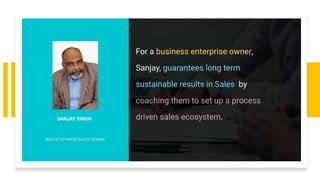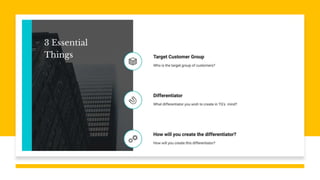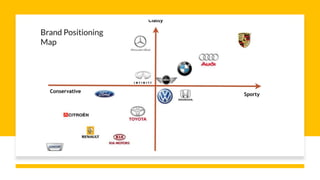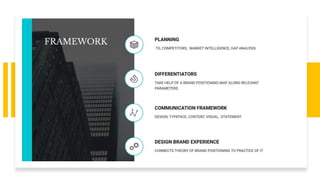Brand Positioning
Download as pptx, pdf0 likes56 views
Consumers mind is the battleground where brand positioning battles are fought. The how and why of this question is the subject matter of things which are so obvious.
1 of 11
Download to read offline











Ad
Recommended
Understanding the Sales Funnel_ A Comprehensive Guide.pptx
Understanding the Sales Funnel_ A Comprehensive Guide.pptxSanjay Singh
╠²
This will help you understand a sales funnel , its importance, its building and its analysisChallenges of Leadership for SME CEO.pptx
Challenges of Leadership for SME CEO.pptxSanjay Singh
╠²
The document outlines crucial leadership lessons for SME CEOs, emphasizing that leadership is attainable for all, not just those with titles. It encourages creating a strong organizational culture, making quick decisions, and fostering team spirit towards a common mission. Additionally, it highlights the importance of measuring leadership effectiveness and taking personal responsibility in developing future leaders.Challenge of Time Management for SME CEO's in India
Challenge of Time Management for SME CEO's in IndiaSanjay Singh
╠²
The document emphasizes the importance of effective time management, suggesting that one's discipline in handling time is what matters, rather than attempting to manage the clock itself. It introduces a 4D methodology for managing tasks and advocates for establishing routines, utilizing technology like Google Calendar, and delegating responsibilities efficiently. Ultimately, it underscores that mastering time allows for balance in work, personal life, and societal contributions.Sales Leadership is your birthright.pptx
Sales Leadership is your birthright.pptxSanjay Singh
╠²
The document emphasizes the essential skills required for aspiring sales leaders, including prospecting, negotiation, and team management. It encourages a proactive mindset, urging leaders to embrace failure as part of the learning process and to differentiate themselves by approaching tasks creatively. Sanjay Singh asserts that continuous training and visionary thinking are vital for achieving success in leadership.The Attitude of Sales drives success.pptx
The Attitude of Sales drives success.pptxSanjay Singh
╠²
The document outlines key strategies for achieving success in sales, emphasizing the importance of a resilient and self-committed attitude. It provides a five-step action plan including self-commitment, effective storytelling, solution selling, negotiating for value, and understanding the ideal customer profile. The overall message encourages salespeople to embrace challenges and view failures as stepping stones to success.The Religion of Sales will make you a Salebrity.pptx
The Religion of Sales will make you a Salebrity.pptxSanjay Singh
╠²
The document presents a philosophy of sales framed as a religion, emphasizing customer service without expectation of immediate returns. It highlights the importance of integrity, authenticity, and making the right connections with customers, while outlining a commitment to never deceive or forget them. Practitioners are warned of the negative consequences of improper sales practices.The Belief Called Sales is a must for all salespersons.pptx
The Belief Called Sales is a must for all salespersons.pptxSanjay Singh
╠²
The document outlines beliefs and affirmations for salespeople, emphasizing the importance of helping customers rather than selling to them. It highlights key beliefs such as the necessity of patience and hard work, and positions the salesperson as a matchmaker for customer needs. The overarching message is that sales success comes from providing solutions and building authentic relationships.Self Discipline in life of a Salesperson.pptx
Self Discipline in life of a Salesperson.pptxSanjay Singh
╠²
The document discusses the importance of self-discipline in sales, emphasizing the need for positive behaviors such as active listening, effective questioning, and value-driven pitching. It highlights that rejections and unreasonable customer demands should be redirected towards understanding customer needs and maintaining professionalism. Additionally, it stresses the significance of respecting customers and acknowledging their cooperation to build strong relationships.DILO (Day in Life of) for Salespersons.pptx
DILO (Day in Life of) for Salespersons.pptxSanjay Singh
╠²
The document outlines the essential daily routine (DILO) of a successful salesperson, emphasizing the importance of structured activities like new contacts, lead follow-ups, and continuous training. It also highlights the need for self-discipline and the ability to adapt to unexpected urgencies while maintaining focus on productivity. Ultimately, adhering to a disciplined daily routine is portrayed as key to achieving long-term success in sales.Market Penetration for Agarbatti Market in India
Market Penetration for Agarbatti Market in IndiaSanjay Singh
╠²
The document discusses strategies for market penetration and expansion through various distribution channels, including dormant and alternate trade channels. It highlights reasons for dormant counters and suggests methods to enhance sales, such as promoting new SKUs and increasing bill value. Additionally, it includes a telecalling script for sales telecallers to engage potential clients effectively.Discover Sales before Inventing your Style
Discover Sales before Inventing your StyleSanjay Singh
╠²
The document discusses key aspects of sales and the role of a salesperson. It defines sales as helping the customer buy and a salesperson as an "angel" who guides customers to find value. It emphasizes that salespersons should attract customers by addressing what's in it for them (WIIFM), build conversations through relevant questions, and keep engagement through dialogue rather than monologue. The responsibilities of a salesperson are to build, monitor, and monetize a sales funnel to generate new customers on an ongoing basis.How to develop networking skills.pptx
How to develop networking skills.pptxSanjay Singh
╠²
This document provides tips and strategies for effective networking. It emphasizes that visibility through networking leads to credibility and profitability. Some key points made include: do not expect to get something from others through networking but rather focus on giving; awareness through networking leads to knowledge; dress professionally and have good etiquette; be a good listener; look for opportunities to make yourself visible such as speaking, organizing, or helping others; and successful leaders have strong networks.Listening Skills.pptx
Listening Skills.pptxSanjay Singh
╠²
The document outlines eight essential listening skills to enhance communication, such as avoiding interruptions, taking notes, and listening for non-verbal cues. It emphasizes the importance of listening with the intent to understand and contribute, fostering better relationships and solutions. The text suggests that great listeners, like famous leaders and wealthy individuals, tend to be more successful in various areas of life.The HIPO Sales Ninja.pptx
The HIPO Sales Ninja.pptxSanjay Singh
╠²
The document discusses the concept of 'high potential sales professionals' (hipo) and what defines a 'sales ninja' as someone who excels in sales. It emphasizes the importance of building sales capability and highlights the idea that sales ninjas focus on maximizing customer lifetime value (CLTV). The overall theme revolves around the attributes and mindset of successful sales individuals.Never give up in sales.pptx
Never give up in sales.pptxSanjay Singh
╠²
This document provides brief tips for salespeople, including that a rejection moves you closer to a sale, asking "why not" questions to turn no into yes, following up with customers, negotiating when a customer says an order is lost, getting references from satisfied customers, acknowledging that challenges will occur in sales, and thanking the reader with contact information.How to manage your sales boss.pptx
How to manage your sales boss.pptxSanjay Singh
╠²
The document discusses challenges in managing a sales boss and provides tips to do so effectively. It notes that salespeople cannot choose their boss and must learn to manage them. Common challenges include bosses holding long meetings, requesting too many reports, changing quotas and goals frequently, and not being hands-on. The tips suggest setting clear daily goals and getting boss approval, using CRM software to automate reports, inviting the boss on sales calls, making sales successes a habit to become the favorite, and standing out by being omnipresent, learning from mistakes, and consistently achieving big deals. The document encourages readers who are still unsure about managing their boss to book a free 15-minute appointment for advice.How to grow small business with small budget.pptx
How to grow small business with small budget.pptxSanjay Singh
╠²
The document outlines the steps necessary for growing a business, emphasizing the importance of visibility, awareness, interest, desire, and sales engagement (AIDA funnel). It provides strategic insights into converting potential customers through targeted approaches and budget management. The success of small businesses hinges not only on budget but also on effective understanding and application of the AIDA marketing principles.How Salespersons should manage their time.pptx
How Salespersons should manage their time.pptxSanjay Singh
╠²
The document outlines various sales and marketing activities that require time planning for a salesperson, including lead generation, nurturing, and closure. It provides a sample daily schedule with activities like an SOD meeting, prospecting, sales follow-ups, and MIS. The document recommends planning weekends for self-introspection and the coming week. It also lists best practices of successful time managers in sales, such as starting early, prioritizing important tasks, daily reporting, and analyzing time management failures.5 ways to promote business.pptx
5 ways to promote business.pptxSanjay Singh
╠²
The document discusses strategies for market penetration, market development, and market visibility. It suggests penetrating existing markets by increasing customers per existing customer and markets per existing market. It proposes developing new markets through acquiring new customer groups, selling additional products to existing customers, and establishing new sales channels or trade routes. It also lists various means of improving market visibility, such as point of purchase displays, billboards, print, electronic, and digital media, as well as other below-the-line promotional activities.3 Sales Follow ups.pptx
3 Sales Follow ups.pptxSanjay Singh
╠²
There are 3 types of follows for a salesperson:
1. Follow up is done after the initial meeting to thank the client and provide additional information like meeting minutes, needs analysis, or product samples.
2. Follow back is done after submitting a sales proposal using value bombs to highlight the product's performance, productivity, and other benefits.
3. Follow through is done if the client says no or not now, using modes like inviting them to a social group or forum related to their interests or a customer engagement program. Doing the right type of follow with the right sales lead is important.Systems Vs Intelligence.pptx
Systems Vs Intelligence.pptxSanjay Singh
╠²
This document outlines systems and procedures to control finances and operations. It recommends setting up systems for finance, marketing, production, human resources, and materials. It provides details on purchase order processes, payment procedures, petty cash controls, end-of-day closing processes, sales department daily tracking, and defining key result areas and key performance indicators for employees. The overall goal is to implement systems and controls to monitor budgets, spending, and employee performance.5 ways to promote business.pptx
5 ways to promote business.pptxSanjay Singh
╠²
The document discusses strategies for market penetration, market development, and market visibility. It suggests penetrating existing markets by increasing customers per existing customer and markets per existing market. It proposes developing new markets through acquiring new customer groups, selling additional products to existing customers, and establishing new sales channels or trade routes. It also lists various means of improving market visibility, such as point of purchase displays, billboards, print/electronic/digital media, out-of-home advertising, and below-the-line promotions.3 Sales Follow ups.pptx
3 Sales Follow ups.pptxSanjay Singh
╠²
There are 3 types of follows in sales:
1. Follow up is done after the initial meeting to thank the client and provide additional information like meeting minutes, needs analysis, or product samples.
2. Follow back is done after submitting a sales proposal and involves highlighting the value propositions of the product through performance, productivity, upgradability, serviceability, usability, profitability, and future proof ability.
3. Follow through is done if the client says no or not now, and includes inviting them to a social group, forum, or customer engagement program related to their interests to continue the relationship.How to manage your sales boss.pptx
How to manage your sales boss.pptxSanjay Singh
╠²
Managing your sales boss is imperative to your success in sales. Since none of us cannot choose our boss, we might as well learn how to manage them
How Salespersons should manage their time.pptx
How Salespersons should manage their time.pptxSanjay Singh
╠²
Every salesperson should know their role and responsibility very clearly and work backwards to manage the time available to them.How to grow small business with small budget.pptx
How to grow small business with small budget.pptxSanjay Singh
╠²
Small business must try to grow their business by following the AIDA principles.3 Types of Sales Follow Up
3 Types of Sales Follow UpSanjay Singh
╠²
The document outlines three types of follow-ups for salespeople: follow up, follow back, and follow through, each with specific communication methods. Follow up occurs after the initial client meeting, follow back follows the submission of a sales proposal, and follow through is conducted after the client declines. Effective communication in these stages is crucial to successful sales engagement.Lead Score.pptx
Lead Score.pptxSanjay Singh
╠²
This document defines different types of sales leads - Marketing Qualified Leads (MQL), Sales Qualified Leads (SQL), and BANT leads. It provides examples of lead repositories with the number of leads of each type and their assigned weights. It then shows how to calculate a lead score by multiplying the number of leads by their weight and dividing by the total leads. The lead score is used to determine if the overall leads are poor, fair, or robust.More Related Content
More from Sanjay Singh (20)
DILO (Day in Life of) for Salespersons.pptx
DILO (Day in Life of) for Salespersons.pptxSanjay Singh
╠²
The document outlines the essential daily routine (DILO) of a successful salesperson, emphasizing the importance of structured activities like new contacts, lead follow-ups, and continuous training. It also highlights the need for self-discipline and the ability to adapt to unexpected urgencies while maintaining focus on productivity. Ultimately, adhering to a disciplined daily routine is portrayed as key to achieving long-term success in sales.Market Penetration for Agarbatti Market in India
Market Penetration for Agarbatti Market in IndiaSanjay Singh
╠²
The document discusses strategies for market penetration and expansion through various distribution channels, including dormant and alternate trade channels. It highlights reasons for dormant counters and suggests methods to enhance sales, such as promoting new SKUs and increasing bill value. Additionally, it includes a telecalling script for sales telecallers to engage potential clients effectively.Discover Sales before Inventing your Style
Discover Sales before Inventing your StyleSanjay Singh
╠²
The document discusses key aspects of sales and the role of a salesperson. It defines sales as helping the customer buy and a salesperson as an "angel" who guides customers to find value. It emphasizes that salespersons should attract customers by addressing what's in it for them (WIIFM), build conversations through relevant questions, and keep engagement through dialogue rather than monologue. The responsibilities of a salesperson are to build, monitor, and monetize a sales funnel to generate new customers on an ongoing basis.How to develop networking skills.pptx
How to develop networking skills.pptxSanjay Singh
╠²
This document provides tips and strategies for effective networking. It emphasizes that visibility through networking leads to credibility and profitability. Some key points made include: do not expect to get something from others through networking but rather focus on giving; awareness through networking leads to knowledge; dress professionally and have good etiquette; be a good listener; look for opportunities to make yourself visible such as speaking, organizing, or helping others; and successful leaders have strong networks.Listening Skills.pptx
Listening Skills.pptxSanjay Singh
╠²
The document outlines eight essential listening skills to enhance communication, such as avoiding interruptions, taking notes, and listening for non-verbal cues. It emphasizes the importance of listening with the intent to understand and contribute, fostering better relationships and solutions. The text suggests that great listeners, like famous leaders and wealthy individuals, tend to be more successful in various areas of life.The HIPO Sales Ninja.pptx
The HIPO Sales Ninja.pptxSanjay Singh
╠²
The document discusses the concept of 'high potential sales professionals' (hipo) and what defines a 'sales ninja' as someone who excels in sales. It emphasizes the importance of building sales capability and highlights the idea that sales ninjas focus on maximizing customer lifetime value (CLTV). The overall theme revolves around the attributes and mindset of successful sales individuals.Never give up in sales.pptx
Never give up in sales.pptxSanjay Singh
╠²
This document provides brief tips for salespeople, including that a rejection moves you closer to a sale, asking "why not" questions to turn no into yes, following up with customers, negotiating when a customer says an order is lost, getting references from satisfied customers, acknowledging that challenges will occur in sales, and thanking the reader with contact information.How to manage your sales boss.pptx
How to manage your sales boss.pptxSanjay Singh
╠²
The document discusses challenges in managing a sales boss and provides tips to do so effectively. It notes that salespeople cannot choose their boss and must learn to manage them. Common challenges include bosses holding long meetings, requesting too many reports, changing quotas and goals frequently, and not being hands-on. The tips suggest setting clear daily goals and getting boss approval, using CRM software to automate reports, inviting the boss on sales calls, making sales successes a habit to become the favorite, and standing out by being omnipresent, learning from mistakes, and consistently achieving big deals. The document encourages readers who are still unsure about managing their boss to book a free 15-minute appointment for advice.How to grow small business with small budget.pptx
How to grow small business with small budget.pptxSanjay Singh
╠²
The document outlines the steps necessary for growing a business, emphasizing the importance of visibility, awareness, interest, desire, and sales engagement (AIDA funnel). It provides strategic insights into converting potential customers through targeted approaches and budget management. The success of small businesses hinges not only on budget but also on effective understanding and application of the AIDA marketing principles.How Salespersons should manage their time.pptx
How Salespersons should manage their time.pptxSanjay Singh
╠²
The document outlines various sales and marketing activities that require time planning for a salesperson, including lead generation, nurturing, and closure. It provides a sample daily schedule with activities like an SOD meeting, prospecting, sales follow-ups, and MIS. The document recommends planning weekends for self-introspection and the coming week. It also lists best practices of successful time managers in sales, such as starting early, prioritizing important tasks, daily reporting, and analyzing time management failures.5 ways to promote business.pptx
5 ways to promote business.pptxSanjay Singh
╠²
The document discusses strategies for market penetration, market development, and market visibility. It suggests penetrating existing markets by increasing customers per existing customer and markets per existing market. It proposes developing new markets through acquiring new customer groups, selling additional products to existing customers, and establishing new sales channels or trade routes. It also lists various means of improving market visibility, such as point of purchase displays, billboards, print, electronic, and digital media, as well as other below-the-line promotional activities.3 Sales Follow ups.pptx
3 Sales Follow ups.pptxSanjay Singh
╠²
There are 3 types of follows for a salesperson:
1. Follow up is done after the initial meeting to thank the client and provide additional information like meeting minutes, needs analysis, or product samples.
2. Follow back is done after submitting a sales proposal using value bombs to highlight the product's performance, productivity, and other benefits.
3. Follow through is done if the client says no or not now, using modes like inviting them to a social group or forum related to their interests or a customer engagement program. Doing the right type of follow with the right sales lead is important.Systems Vs Intelligence.pptx
Systems Vs Intelligence.pptxSanjay Singh
╠²
This document outlines systems and procedures to control finances and operations. It recommends setting up systems for finance, marketing, production, human resources, and materials. It provides details on purchase order processes, payment procedures, petty cash controls, end-of-day closing processes, sales department daily tracking, and defining key result areas and key performance indicators for employees. The overall goal is to implement systems and controls to monitor budgets, spending, and employee performance.5 ways to promote business.pptx
5 ways to promote business.pptxSanjay Singh
╠²
The document discusses strategies for market penetration, market development, and market visibility. It suggests penetrating existing markets by increasing customers per existing customer and markets per existing market. It proposes developing new markets through acquiring new customer groups, selling additional products to existing customers, and establishing new sales channels or trade routes. It also lists various means of improving market visibility, such as point of purchase displays, billboards, print/electronic/digital media, out-of-home advertising, and below-the-line promotions.3 Sales Follow ups.pptx
3 Sales Follow ups.pptxSanjay Singh
╠²
There are 3 types of follows in sales:
1. Follow up is done after the initial meeting to thank the client and provide additional information like meeting minutes, needs analysis, or product samples.
2. Follow back is done after submitting a sales proposal and involves highlighting the value propositions of the product through performance, productivity, upgradability, serviceability, usability, profitability, and future proof ability.
3. Follow through is done if the client says no or not now, and includes inviting them to a social group, forum, or customer engagement program related to their interests to continue the relationship.How to manage your sales boss.pptx
How to manage your sales boss.pptxSanjay Singh
╠²
Managing your sales boss is imperative to your success in sales. Since none of us cannot choose our boss, we might as well learn how to manage them
How Salespersons should manage their time.pptx
How Salespersons should manage their time.pptxSanjay Singh
╠²
Every salesperson should know their role and responsibility very clearly and work backwards to manage the time available to them.How to grow small business with small budget.pptx
How to grow small business with small budget.pptxSanjay Singh
╠²
Small business must try to grow their business by following the AIDA principles.3 Types of Sales Follow Up
3 Types of Sales Follow UpSanjay Singh
╠²
The document outlines three types of follow-ups for salespeople: follow up, follow back, and follow through, each with specific communication methods. Follow up occurs after the initial client meeting, follow back follows the submission of a sales proposal, and follow through is conducted after the client declines. Effective communication in these stages is crucial to successful sales engagement.Lead Score.pptx
Lead Score.pptxSanjay Singh
╠²
This document defines different types of sales leads - Marketing Qualified Leads (MQL), Sales Qualified Leads (SQL), and BANT leads. It provides examples of lead repositories with the number of leads of each type and their assigned weights. It then shows how to calculate a lead score by multiplying the number of leads by their weight and dividing by the total leads. The lead score is used to determine if the overall leads are poor, fair, or robust.